In 1990 werd de ruimtetelescoop Hubble gelanceerd. Zie hier op deze foto van de NASA het ding in een baan om de aarde vliegen.
Het lijkt meer op een blik schroot dat door een handig neefje in elkaar is gezet dan op een hightech-telescoop, maar het kan prachtige foto’s van het universum maken. Op de site van de NASA kan je een hoop van deze foto’s bekijken.
Ik heb hieronder vijf van deze foto’s gezet (met onder de foto’s telkens het originele commentaar van de NASA bij de foto, zodat u wat meer wetenschappelijk kunt lezen wat er te zien is.) Wat dacht u bijvoorbeeld van deze sterrenhemel.
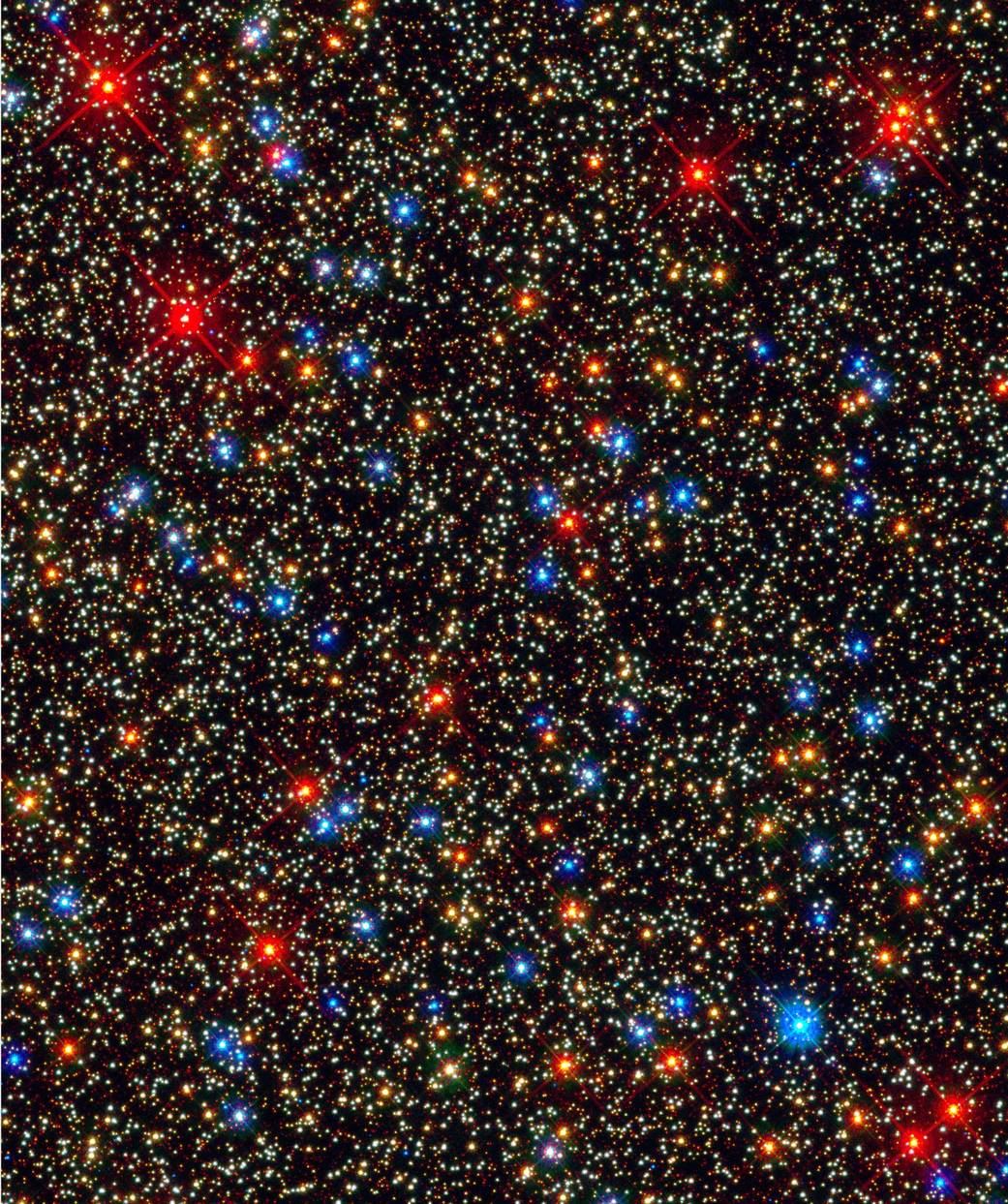 (NASA’s Hubble Space Telescope snapped this panoramic view of a colorful assortment of 100,000 stars residing in the crowded core of a giant star cluster. This is one of the first images taken by the new Wide Field Camera 3 that was installed aboard Hubble in May 2009 during Servicing Mission 4, which can snap sharp images over a broad range of wavelengths. Image Credit: NASA)
(NASA’s Hubble Space Telescope snapped this panoramic view of a colorful assortment of 100,000 stars residing in the crowded core of a giant star cluster. This is one of the first images taken by the new Wide Field Camera 3 that was installed aboard Hubble in May 2009 during Servicing Mission 4, which can snap sharp images over a broad range of wavelengths. Image Credit: NASA)
Of deze vliegende kwal in de ruimte:
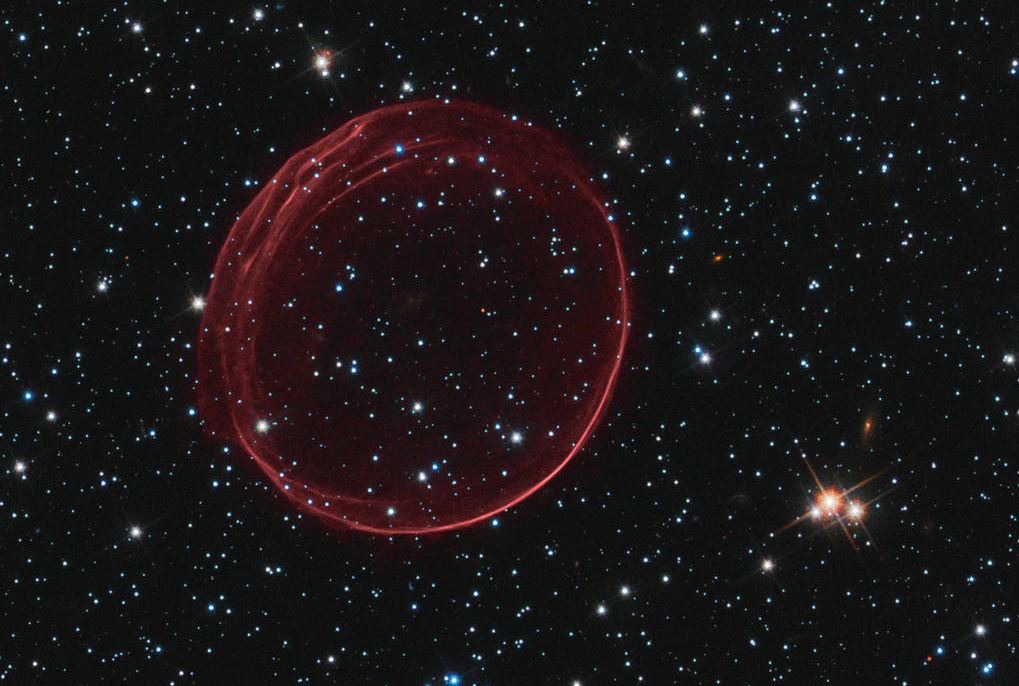 (Who thought space could be so festive? The title of the image for 2010 is “Hubble Supernova Bubble Resembles Holiday Ornament.” Aptly named, right? Well, the ring is from gas that is being shocked by the expanding blast wave from a supernova. Doesn’t the ring look small from where we stand? It’s actually 23 light-years across and expands at more than 11 million miles per hour.)
(Who thought space could be so festive? The title of the image for 2010 is “Hubble Supernova Bubble Resembles Holiday Ornament.” Aptly named, right? Well, the ring is from gas that is being shocked by the expanding blast wave from a supernova. Doesn’t the ring look small from where we stand? It’s actually 23 light-years across and expands at more than 11 million miles per hour.)
Er gelden ook snelheidslimieten in de ruimte. In dit deel van het universum mag je volgens deze sterrencijfers niet harder dan 10 km per uur.
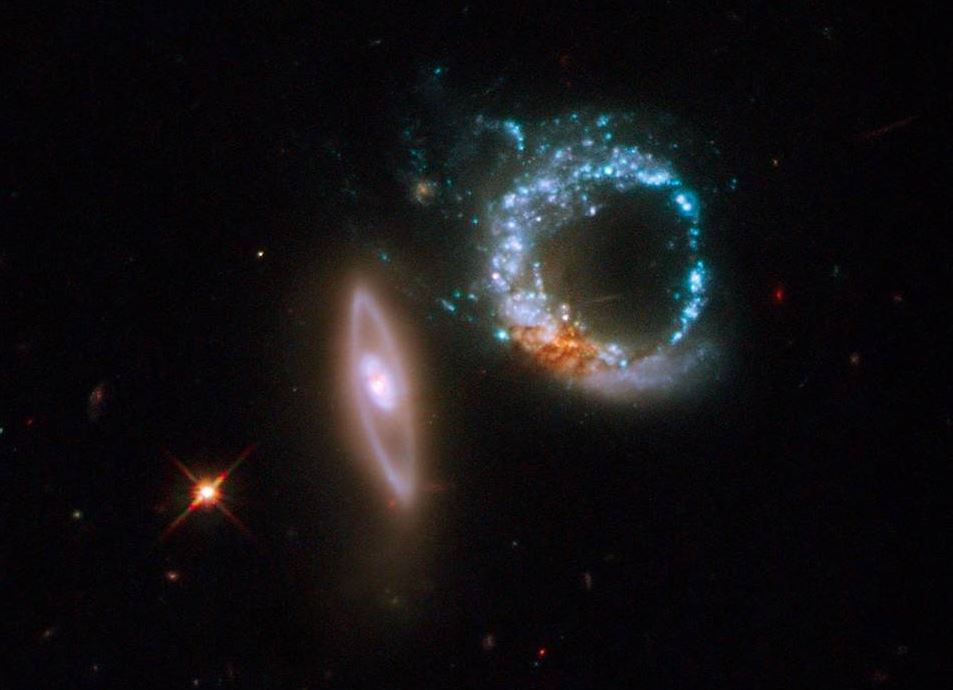 (The two galaxies are oriented so that they appear to mark the number 10. The left-most galaxy, or the “one” in this image, is relatively undisturbed apart from a smooth ring of starlight. It appears nearly on edge to our line of sight. The right-most galaxy, resembling a zero, exhibits a clumpy, blue ring of intense star formation. The blue ring was most probably formed after the galaxy on the left passed through the galaxy on the right. Just as a pebble thrown into a pond creates an outwardly moving circular wave, a propagating density wave was generated at the point of impact and spread outward. As this density wave collided with material in the target galaxy that was moving inward due to the gravitational pull of the two galaxies, shocks and dense gas were produced, stimulating star formation. The galaxy pair was photographed on October 27-28, 2008. Arp 147 lies in the constellation Cetus, more than 400 million light-years from Earth. Image Credit: NASA, ESA, and M. Livio (STScI))
(The two galaxies are oriented so that they appear to mark the number 10. The left-most galaxy, or the “one” in this image, is relatively undisturbed apart from a smooth ring of starlight. It appears nearly on edge to our line of sight. The right-most galaxy, resembling a zero, exhibits a clumpy, blue ring of intense star formation. The blue ring was most probably formed after the galaxy on the left passed through the galaxy on the right. Just as a pebble thrown into a pond creates an outwardly moving circular wave, a propagating density wave was generated at the point of impact and spread outward. As this density wave collided with material in the target galaxy that was moving inward due to the gravitational pull of the two galaxies, shocks and dense gas were produced, stimulating star formation. The galaxy pair was photographed on October 27-28, 2008. Arp 147 lies in the constellation Cetus, more than 400 million light-years from Earth. Image Credit: NASA, ESA, and M. Livio (STScI))
Op deze foto is een enorme gaswolk in de ruimte te zien:
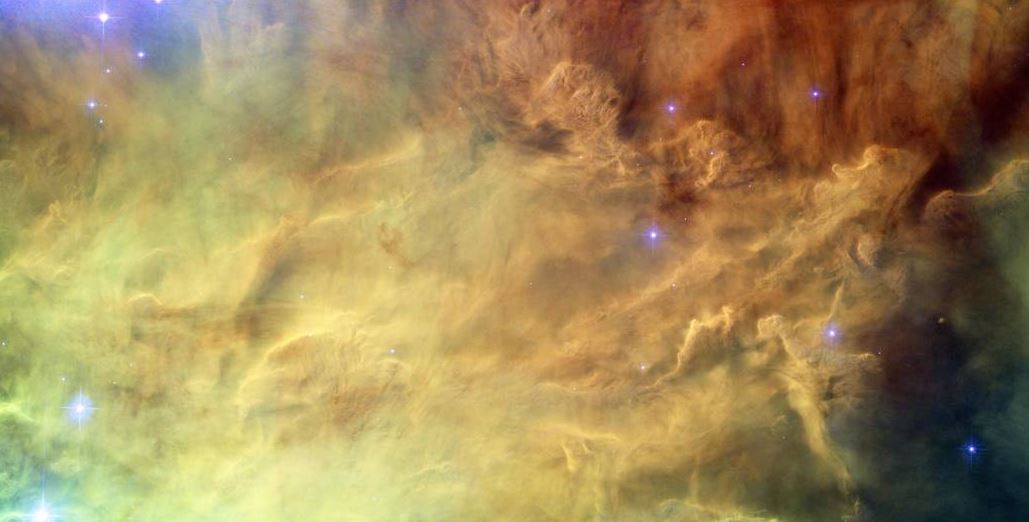 (Like brush strokes on a canvas, ridges of color seem to flow across the Lagoon Nebula, a canvas nearly 3 light-years wide. The colors map emission from ionized gas in the nebula were recorded by the Hubble Space Telescope’s Advanced Camera for Surveys. Also known as M8, the nebula is a star-forming region in the constellation Sagittarius. Hubble’s remarkably sharp, close-up view reveals undulating shapes sculpted by the energetic light and winds from the region’s new born stars. Of course, the Lagoon Nebula is a popular target for earthbound skygazers, too. Image Credit: NASA)
(Like brush strokes on a canvas, ridges of color seem to flow across the Lagoon Nebula, a canvas nearly 3 light-years wide. The colors map emission from ionized gas in the nebula were recorded by the Hubble Space Telescope’s Advanced Camera for Surveys. Also known as M8, the nebula is a star-forming region in the constellation Sagittarius. Hubble’s remarkably sharp, close-up view reveals undulating shapes sculpted by the energetic light and winds from the region’s new born stars. Of course, the Lagoon Nebula is a popular target for earthbound skygazers, too. Image Credit: NASA)
De Paardennevel is één van de meest gefotografeerde zaken in de ruimte. Hij werd al in 1888 voor het eerst op de foto vastgelegd.
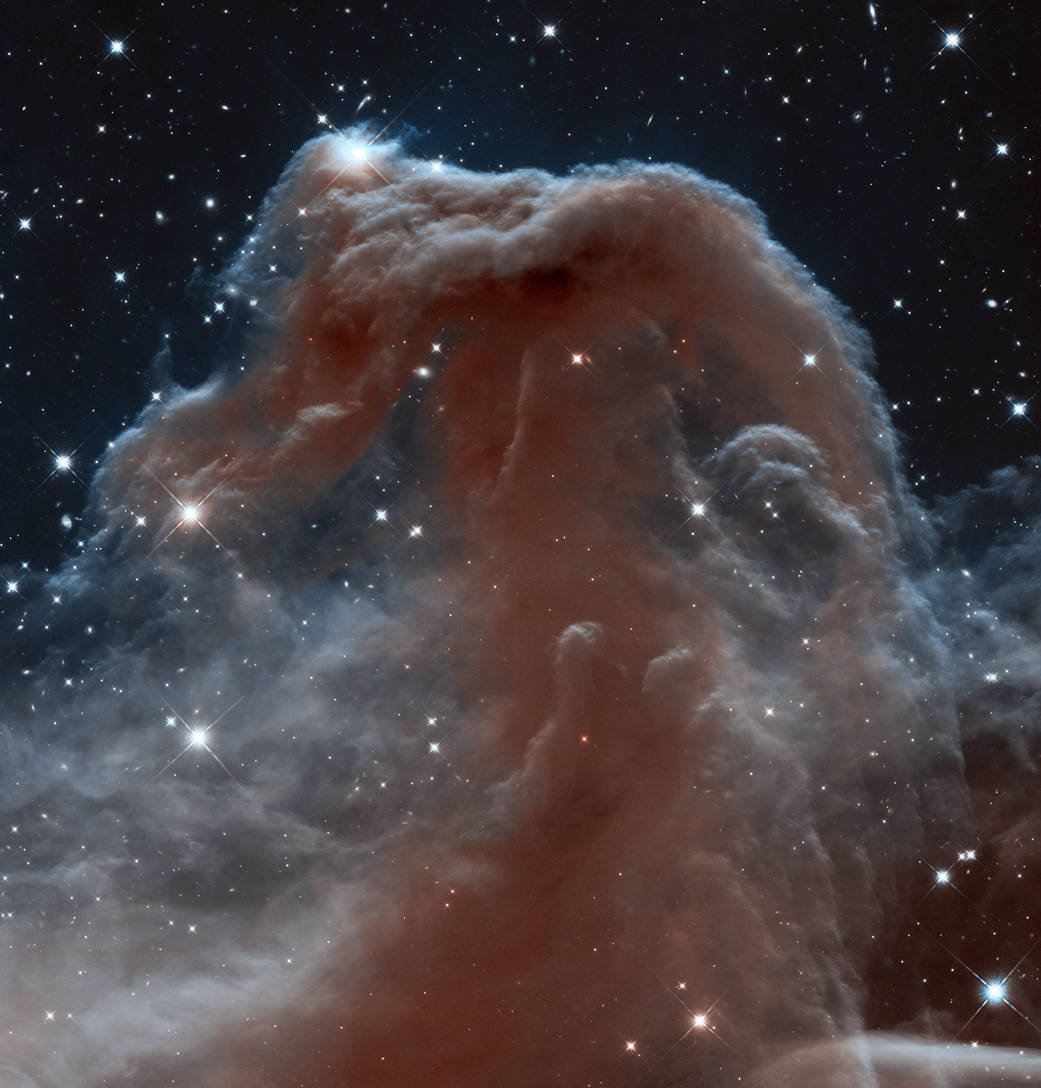 (Astronomers have used NASA’s Hubble Space Telescope to photograph the iconic Horsehead Nebula in a new, infrared light to mark the 23rd anniversary of the famous observatory’s launch aboard the space shuttle Discovery on April 24, 1990. Looking like an apparition rising from whitecaps of interstellar foam, the iconic Horsehead Nebula has graced astronomy books ever since its discovery more than a century ago. The nebula is a favorite target for amateur and professional astronomers. It is shadowy in optical light. It appears transparent and ethereal when seen at infrared wavelengths. The rich tapestry of the Horsehead Nebula pops out against the backdrop of Milky Way stars and distant galaxies that easily are visible in infrared light. Image Credit: NASA/ESA/Hubble Heritage Team)
(Astronomers have used NASA’s Hubble Space Telescope to photograph the iconic Horsehead Nebula in a new, infrared light to mark the 23rd anniversary of the famous observatory’s launch aboard the space shuttle Discovery on April 24, 1990. Looking like an apparition rising from whitecaps of interstellar foam, the iconic Horsehead Nebula has graced astronomy books ever since its discovery more than a century ago. The nebula is a favorite target for amateur and professional astronomers. It is shadowy in optical light. It appears transparent and ethereal when seen at infrared wavelengths. The rich tapestry of the Horsehead Nebula pops out against the backdrop of Milky Way stars and distant galaxies that easily are visible in infrared light. Image Credit: NASA/ESA/Hubble Heritage Team)
Hier zien we het lot dat onze zon ooit staat te wachten: een ster in zijn eindfase.
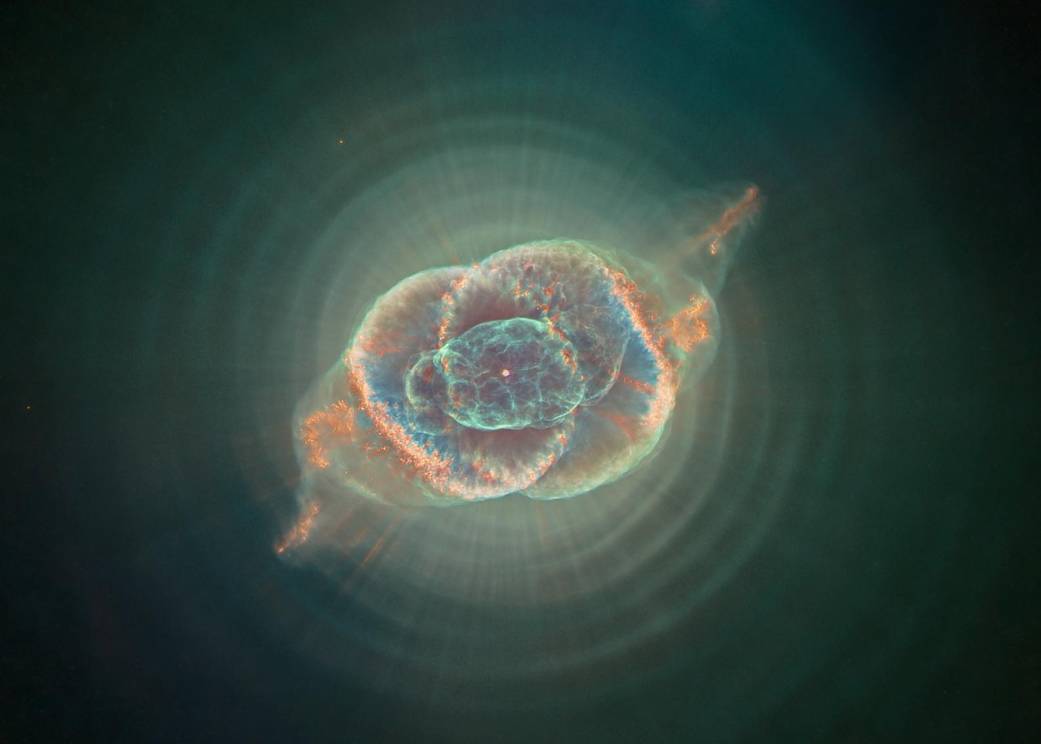 (Staring across interstellar space, the alluring Cat’s Eye Nebula lies 3,000 light-years from Earth. The Cat’s Eye (NGC 6543) represents a brief, yet glorious, phase in the life of a sun-like star. This nebula’s dying central star may have produced the simple, outer pattern of dusty concentric shells by shrugging off outer layers in a series of regular convulsions. […] Of course, gazing into the Cat’s Eye, astronomers may well be seeing the fate of our sun, destined to enter its own planetary nebula phase of evolution … in about 5 billion years. Image Credit: NASA, MAST, STScI, AURA and Vicent Peris (OAUV/PTeam)
(Staring across interstellar space, the alluring Cat’s Eye Nebula lies 3,000 light-years from Earth. The Cat’s Eye (NGC 6543) represents a brief, yet glorious, phase in the life of a sun-like star. This nebula’s dying central star may have produced the simple, outer pattern of dusty concentric shells by shrugging off outer layers in a series of regular convulsions. […] Of course, gazing into the Cat’s Eye, astronomers may well be seeing the fate of our sun, destined to enter its own planetary nebula phase of evolution … in about 5 billion years. Image Credit: NASA, MAST, STScI, AURA and Vicent Peris (OAUV/PTeam)
Waarom schrijf ik nu over de Hubble telescoop? Dat komt omdat ze hem gisteren even in de veilige modus hebben gezet. (Net zoals u Windows op uw pc in de veilige modus kan zetten.) De telescoop heeft zes gyroscopen aan boord. Daarvan waren er al drie kapot maar nu heeft ook een vierde het begeven. Weliswaar kan de Hubble ook werken met één of twee gyroscopen maar lang niet zo snel en goed als met minstens drie goed werkende gyroscopen. De NASA heeft daarom de Hubble in de veilige modus gezet en onderzoekt momenteel wat de beste oplossing voor dit probleem is.
Nu is het zo dat de Hubble vaker problemen heeft gehad. Tot vier keer toe heeft de NASA er een mannetje naar toegestuurd om deze problemen op te lossen. Zo zijn in 2009 nog alle zes gyroscopen vervangen (waarschijnlijk is de garantietermijn verlopen nu.)
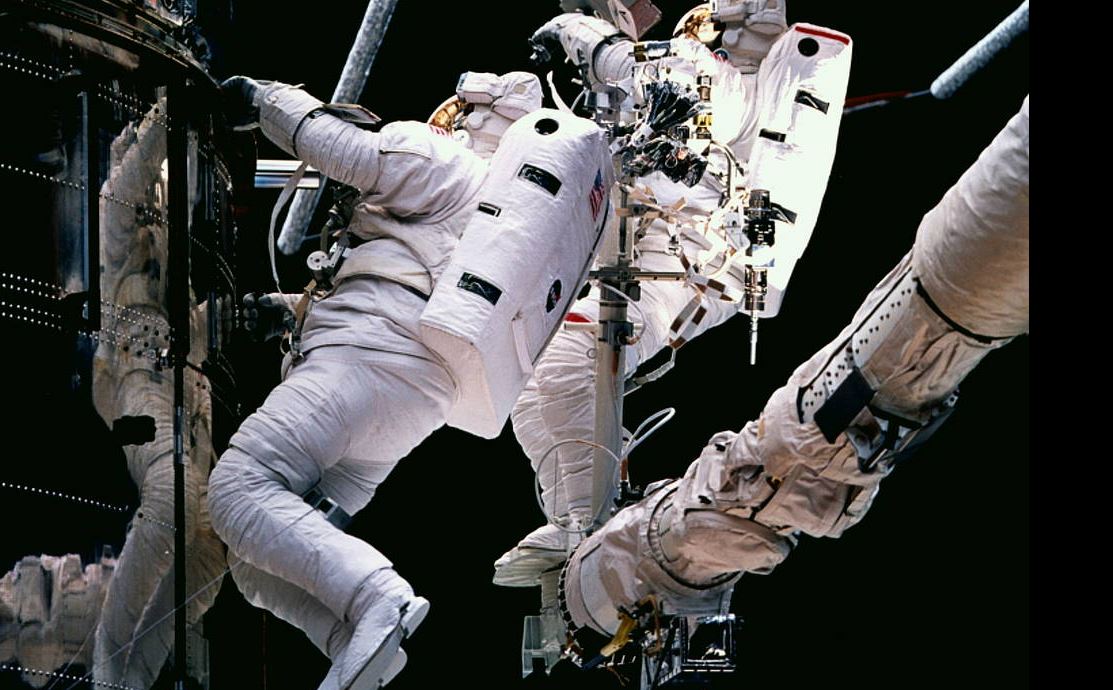 Een mannetje aan het werk bij de Hubble
Een mannetje aan het werk bij de Hubble
Het probleem voor de NASA is dat de mannetjes geen busje (lees Spaceshuttle) meer hebben om er te komen. Ik hoop in ieder geval dat ze een oplossing vinden (Control Backspace?), want ik vind het altijd reuze interessante foto’s.

